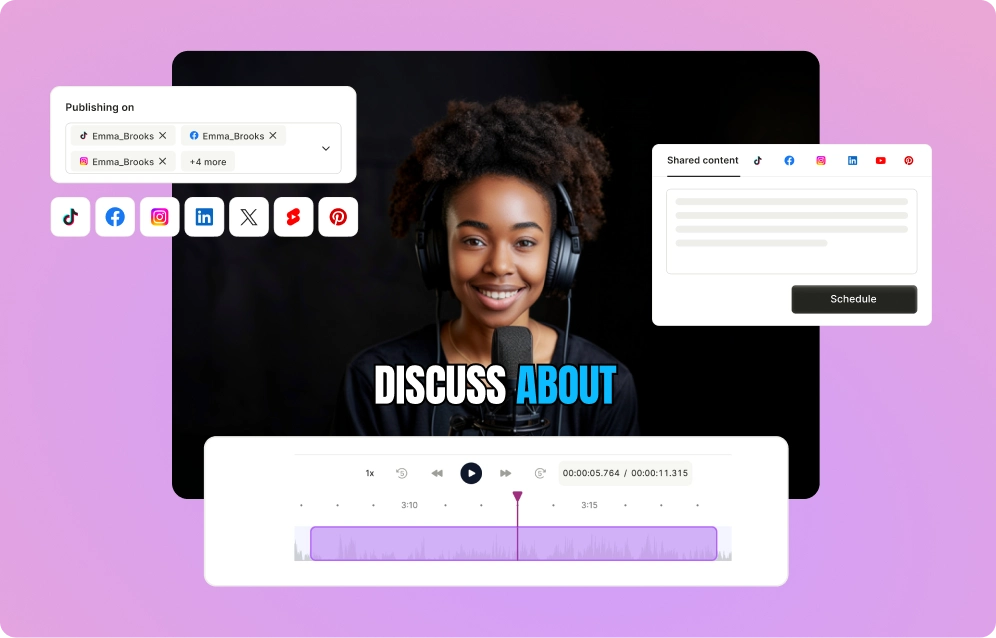Empower Your Digital Story
Social media isn’t just a marketing channel anymore—it’s the core of how businesses engage, sell, and grow. In 2025, staying ahead means embracing fast-moving trends while ensuring every post, video, and campaign delivers measurable ROI. So, what’s shaping the next era of social media marketing?
Our latest report, backed by insights from Sprout Social, Hootsuite, and The Business Research Company, breaks it down. Here’s what you need to know.
{{cta-richtext}}
1. Video Content Is Still King—But It’s Changing
Short-form videos continue to dominate, but don’t underestimate long-form content. TikTok, Instagram Reels, and YouTube Shorts are evolving, allowing videos up to 3 minutes long. Why? Users want both snackable and immersive experiences. The key is repurposing video content across platforms—but customizing it for each platform’s culture.
Key Insights:
- YouTube remains one of the top 3 platforms for user engagement.
- Brands like Checkbone Beauty are mastering multi-platform video strategies—from TikTok tutorials to LinkedIn thought leadership.
- Expect platforms to push longer, more interactive video formats, catering to deeper engagement.
What You Should Do: Start creating video content with both short-form and long-form storytelling in mind. Don’t just recycle clips—adapt them to fit each platform’s unique audience.
2. AI: The New Strategic Partner in Social Media
AI is no longer a tool—it’s an essential part of marketing. 83% of marketers already use AI to scale content production (Hootsuite). But in 2025, it’s going beyond content generation.
Brands are using AI for:
- Sentiment analysis to predict audience reactions and prevent PR crises.
- AI-powered social listening to identify real-time trends and engagement opportunities.
- Content personalization that dynamically tailors messaging to different audience segments.
Example: Mastercard leverages AI-powered social listening to identify “priceless moments,” allowing them to proactively engage with customers and drive conversions.
Takeaway: AI is your assistant and strategist. Automate repetitive tasks, but ensure human oversight to maintain authenticity.
3. The Creator Economy is Shifting (Again)
Mega-influencers? Overrated. Micro-influencers (1K–50K followers) are proving more valuable, with 93% of consumers favoring brands that collaborate with niche creators (Sprout Social). The focus is shifting to:
- B2B creators: LinkedIn’s “Brandfluencers” (like LG) are turning professional thought leaders into brand advocates.
- Community-driven partnerships: Rather than broad influencer deals, brands are doubling down on creators who resonate with specific audience segments.
What’s Next? Expect influencer marketing to become more specialized. Instead of massive followings, brands will prioritize engagement, trust, and niche relevance.
4. Cultural Fluency is a Double-Edged Sword
Jumping on social trends can make or break your brand. 90% of consumers use social media to track trends, but 33% find brands’ participation in trends embarrassing if it feels forced (Sprout Social).
The Winning Approach:
- Brands like Marc Jacobs succeed by collaborating with niche creators and referencing subcultural memes authentically.
- The Pitfall: Trying too hard to be “relatable” can backfire if audiences see it as inauthentic.
Pro Tip: Before hopping on a viral trend, ask: Does this align with my brand? If the answer is shaky, skip it.
5. Niche Communities Are Moving Offline
The rise of hyper-niche digital communities is leading to real-world experiences. Platforms like Lapse prioritize “friendship over followers,” encouraging deeper, more meaningful engagement.
Brands are leveraging this by:
- Hosting exclusive meetups for online communities.
- Using AI-driven event curation (like 222’s AI-powered personalized meetups).
Why This Matters: Social media isn’t just about engagement anymore—it’s about building real-world loyalty.
6. Social Commerce: It’s About Quality, Not Just Hype
Social commerce is evolving beyond impulse buys. 63% of consumers now prioritize product quality over virality, and 73% will switch brands if social customer care is slow (Sprout Social).
What’s Changing?
- Instagram’s “Shopping” tab drives 44% of weekly shoppers, proving that discovery still happens on social platforms.
- Customer experience matters more than ever. A viral campaign means nothing if customers aren’t taken care of post-purchase.
What To Do: Build social commerce strategies that focus on quality storytelling, strong customer support, and transparent brand values.
7. Data-Driven Agility is Now a Non-Negotiable
62% of marketers rely on social listening to prove ROI (Hootsuite). The social media market is projected to hit $466.56B by 2029, driven by mobile adoption and e-commerce (The Business Research Company).
What’s Driving This?
- AI-powered analytics tools are now seamlessly integrating with CRM systems.
- Brands are moving beyond just engagement metrics—they’re connecting social data directly to revenue and sales strategies.
Pro Tip: If you’re not tracking real-time audience insights and adjusting your strategy dynamically, you’re already behind.
{{cta-richtext}}
Challenges to Watch Out For
With all these exciting trends, there are still some roadblocks brands need to navigate:
- Trend Fatigue: 27% of trends lose impact within 24–48 hours (Sprout Social). Jumping on everything is exhausting and unsustainable.
- Authenticity vs. Automation: AI-generated content can feel soulless if overused. Human oversight is critical.
- Privacy Concerns: Data transparency is non-negotiable, especially for industries dealing with sensitive information.
Final Thoughts: What You Need to Prioritize in 2025
To stay ahead in the social media landscape, you need to:
- Invest in AI—but keep the human touch. Automation is powerful, but real engagement still needs human input.
- Double down on video and social search. Younger audiences are using TikTok and YouTube instead of Googlefor searches.
- Prioritize micro-influencers over mass appeal. Niche engagement beats broad reach.
- Embed social listening into your marketing strategy. Track audience sentiment, competitor moves, and emerging trends in real time.
- Experiment boldly—but avoid chasing every trend. Test platforms like Threads, but don’t stretch your brand too thin.
The bottom line? Agility wins. The brands that thrive in 2025 won’t be the fastest or the loudest—they’ll be the smartest.
Want to see the full breakdown of 2025’s social media trends?
Read the full report now and future-proof your social media strategy.




.webp)

.png)
.png)
.png)

